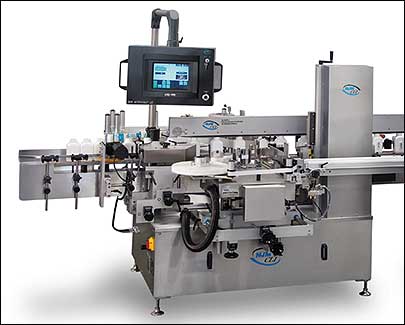Mar 18, 2005NJM/CLI, a manufacturer of packaging and labeling systems based in Lebanon, N.H., has released the RFID Integrated Auto-Colt III System, a pressure-sensitive in-line bottle labeler that can apply RFID-embedded labels to individual plastic or glass containers—and eject those with incorrect or nonfunctioning EPC tags from the line. The labeler applies preprinted and pre-encoded labels embedded with HF or UHF passive RFID tags.
The company developed the Auto-Colt III item-level tagging system last year while helping its customer Purdue Pharma devise a method of tagging its Schedule II narcotics. The development work included a pilot project that applied RFID tags to bottles of the MS Contin and OxyContin painkillers shipped to pharmacies for dispensing (see Purdue Pharma Gets Down to the Item). It is now offering the system to all its customers.
Bill Delmolino, NJM/CLI vice president of technical sales, says pharmaceutical manufacturers that will be sending pill bottles into a hospital supply chain need to use HF (13.56 MHz) tags, instead of UHF, in order to avoid interference with various UHF systems used in hospitals. But pharmaceutical companies shipping tagged items to Wal-Mart or other retailers can use UHF tags to meet those retailers' requirements.
In developing the system for the Purdue Pharma pilot, NJM/CLI worked with system integrator Northern Apex to retrofit NJM/CLI's Auto-Colt III System with an RFID reader and antenna from Matrics (now owned by Symbol Technologies) and a software interface that allows the operator to communicate with the labeler and set up the RFID verification process for Symbol Class 0 and 0+ tags. Delmolino says that NJM/CLI is working with other systems integrators to enable the labeling system to function with other types of tags, pursuant to the wishes of the customer.
The reader is linked to the labeler's programmable logic controller (PLC), a standard device used to monitor and control automated conveyor lines. The PLC is programmed to eject a bottle if the reader does not get a clear RF signal from it that indicates the tag is functional. The PLC is also programmed to verify that the bottle's tag bears the correct EPC code. For example, the EPC code for a bottle of a specific drug with a quantity of 10 pills is different than the EPC code for a bottle of the same drug with 20 pills.
For each labeling job, an operator uses a touch-screen monitor to select the type and quantity of product to be labeled and the corresponding EPC code. The Auto-Colt III then applies a smart label to each container for that product. As a tagged container passes an electronic eye, the reader interrogates the tag and sends the result to the PLC. If the reader picks up a RF signal and the PLC verifies that the EPC code is correct, it sends the bottle down the line. If the tag is nonfunctioning or the EPC number is incorrect, the PLC sends a command to a blower to reject the bottle.
The Auto-Colt III labeler handles round, oval, square and rectangular containers from 1 to 14 inches in height and from 5/8 to 7 inches in width. It can apply up to 250 labels per minute, even with the RFID verification process, according to Delmolino. The labeler is part of a larger packaging system in which the bottles are filled, sealed and capped before the label is placed on the container. At each of these steps in the packaging process, a sensor is used to verify that each container is being packaged as it should be. If a bottle is missing its cap, for example, a sensor will detect that absence and an arm or blower will divert the bottle off the line.
By placing the RFID-embedded label onto the containers at the end of the process, it protects the chip from being damaged during the filling and capping process. Delmolino explains that in order to simplify recordkeeping, pharmaceutical manufacturers want the bottles that are rejected because of a missing cap kept separate from the bottles rejected because of a dysfunctional or inaccurate label.
In pharmaceutical labeling and packaging operations, every step of the process is tightly monitored by the drugmakers in compliance with FDA's 21 CFR Part 11 regulations, which, in order to ensure the integrity of the product, require companies to maintain electronic records and signatures relating to the manufacture and transportation of pharmaceuticals. At the end of each day, says Delmolino, the drugmakers must account for all of the pills that are packaged and labeled.
The RFID Integrated Auto-Colt III system is available now, but pricing information is not being released.


